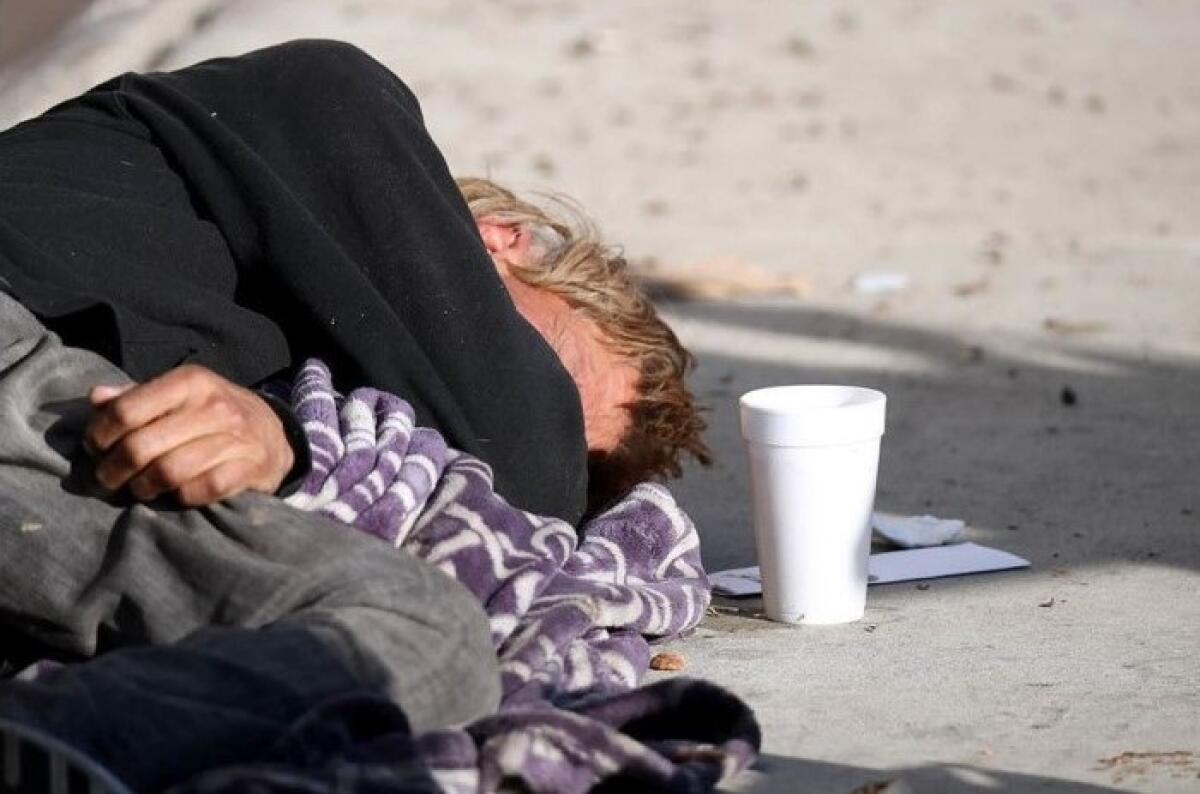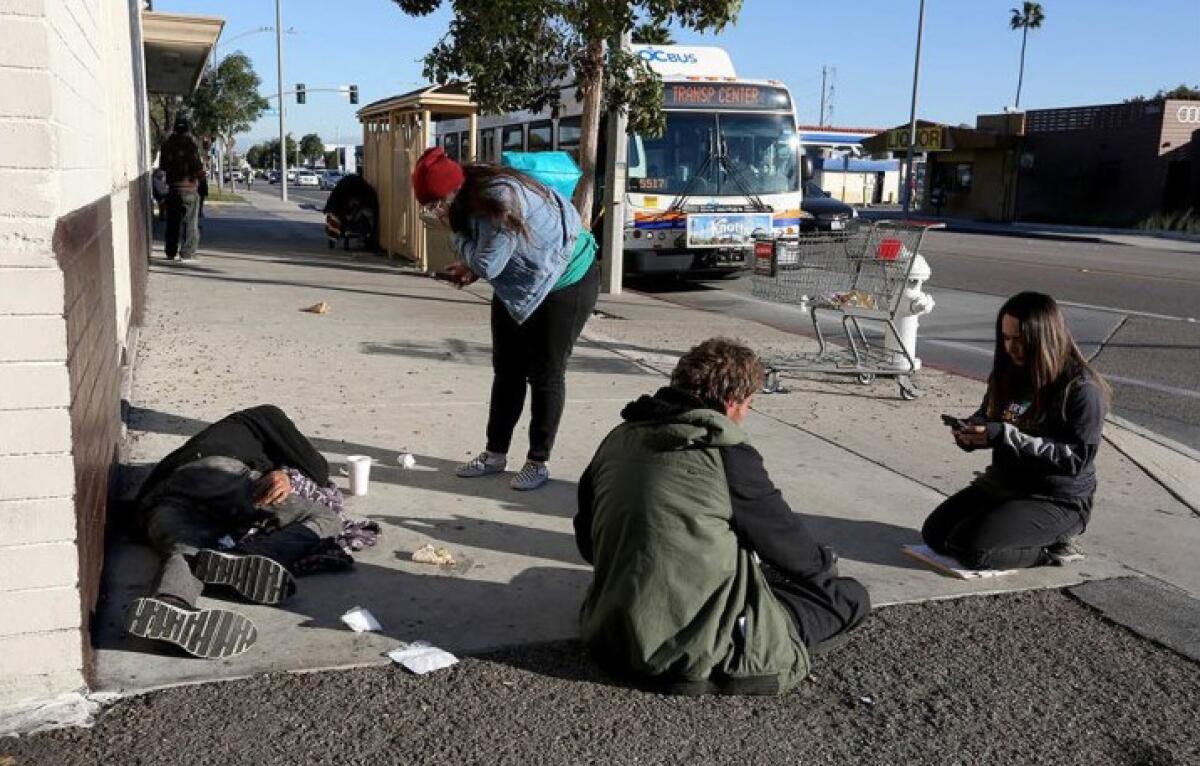As homeless overdose deaths spiral, Santa Ana clamps down on business that helps homeless and drug users

- Share via
As scores of homeless people continue to die of overdoses in Orange County, a business that provides care to homeless people and drug users in Santa Ana may have to shut down as the city threatens to revoke its occupancy permit.
But the founders of the Harm Reduction Institute at the American Addiction Institute of Mind and Medicine are not going quietly. They contend that the institute performs an essential function for the city’s homeless population by providing counseling, clean syringes, wound care and the lifesaving opioid reversal drug, naloxone, to people who rely on the resources for survival.
The institute has been operating out of an office at 1533 E. 4th St. since 2019, when it was co-founded by Dr. Faried Banimahd and Mahan Naeim, a UC Irvine medical student.
But on Nov. 17, the city sent a letter notifying the institute that the city plans to revoke its certificate of occupancy because the institute is not operating as a medical office. On Monday, the institute hit back with a letter from its attorney, which took issue with the city’s claims.
Naeim believes that the institute is being targeted because it serves people who use drugs, who are typically homeless. Naeim said over the phone that the institute serves more than 1,200 clients.
“They are definitely targeting our service, and they’re using the certificate of occupancy as a means of targeting it,” Naeim said. “I think they are primarily targeting it because of the people that we serve, as a part of a coordinated effort from Santa Ana to deny services to those who are unhoused.”
According to a notice signed by Minh Thai, executive director of the city’s planning and building agency, the institute has not been operating as a “medical office,” despite the city approving it under that designation. Therefore, Thai wrote, the institute is violating zoning laws.
The notice contends that the counseling and syringe services, along with wound care, are not the functions of a medical office. Instead, the city defines the institute as an “outpatient addiction treatment clinic.”
If the business loses its certificate of occupancy for a specific use, it can’t use the building for that use, but it could get a new certificate for other business activities that are allowed, Santa Ana city spokesman Paul Eakins said in an email.
Jeremy Tolchin, an attorney representing the institute, said that the business will essentially be kicked out of the building if the certificate is revoked.

In a response letter Tolchin sent to the city on Monday, he argued that the institute fits the criteria of a medical office.
“The city’s effort to revoke my client’s certificate of occupancy is a pretextual, illegal, unconstitutional, and counterfactual effort to prevent my client from continuing its operations in the city of Santa Ana,” the response reads. “The notice is premised on the position that AAIMM is not operating as a medical office; i.e. that counseling and substance use disorder treatment services are not medical in nature or performed at a medical office. In advancing this argument, the city cherry picks facts and ignores science, medicine, law, reality, and its own practices.”
In his letter, Tolchin said that the city’s position that providing counseling or substance use treatment services is not a function of a medical office is “anachronistic nonsense.”
“As the city may or may not be aware, the human brain is in fact attached to the human body,” Tolchin said in the letter before providing a diagram of the internal organs of the human body, which did indeed reveal that the brain is encased in the human body.
“Because the brain is a part of the body, the professional treatment of its afflictions (including substance use disorder) is medical in nature. The treatment of mental health and substance use disorders, in fact, have parity with the treatment of other medical afflictions as a public policy and by law ... Mental health and substance use disorder treatment (including counseling services) are within the purview of those services offered by a medical office. More importantly, the services that are offered by AAIMM are those that fall within the purview of a medical office.”
Tolchin said that the city has not been consistent with its contention that counseling services are not a permitted business in the Professional Zone, which the institute is located in. The attorney provided a list of businesses that offer counseling and substance use disorder counseling services that the city approved for operation in a Professional Zone.
Tolchin said that the city appears to be isolating the institute, which he said is unconstitutional.
“As evidenced by the city’s approval of certificates of occupancy for dozens of other businesses offering mental health and substance use disorder counseling services in the Professional Zone, it is quite clear that ‘counseling services’ — i.e. mental and behavioral health care — are encompassed by the uses specifically enumerated in [the city’s zoning code],” Tolchin wrote. “The City, however, wishes to exclude only AAIMM’s business and only the mental health and counseling services offered by AAIMM.
”...”The Equal Protection Clause of the Fourteenth Amendment commands that no State shall ‘deny to any person within its jurisdiction the equal protection of the laws,’ which is essentially a direction that all persons similarly situated should be treated alike,” Tolchin wrote. “The city has offered no legitimate basis to treat my client in a different manner than those that are similarly situated. Such disparate treatment is itself actionable against the city.”
Eakins said in an email earlier this week that the city is not commenting on the “pending code enforcement matter.” Whether the city has changed its outlook since Tolchin’s letter was also unclear during an administrative hearing on Wednesday.
During that short hearing, the institute’s legal team reiterated its argument from Tolchin’s letter and sought an update on the city’s view on the matter. But Thai, who led the hearing, refused and said the point of the meeting was to allow the institute to be heard before he makes a decision on the permit, which will occur within 30 days of the hearing.
Tolchin said they could appeal the city’s verdict.
“Nonetheless, we expected that the city would provide a hearing that offered a minimal level of due process,” Tolchin said in an email following the hearing. “We expected the city to allow a neutral arbiter to consider the issues, address the arguments laid out in our response, or at least make a statement of some kind. This did not happen.
“Instead, the city offered a show trial — a fig leaf. We were forced to present our position to the very person who decided to revoke the certificate of occupancy in the first place. At the same time, the city provided no further justification and no substantive response to the merits of our client’s position.”

Naeim said that the harm reduction services that the institute provides is crucial for Orange County public health. There is currently a deficit of harm reduction services in the county and the U.S. just topped 100,000 overdose deaths this year for the first time. Meanwhile, Naeim said that naloxone distributed by the institute has saved about 2,800 lives.
Orange County is also seeing a record year in the number of homeless deaths, many of which result from drug overdoses.
Naeim said that the institute is the only program in the county providing sterile syringes and disposing of used ones. Advocates of syringe exchanges say that access to clean needles keeps intravenous drug users from sharing syringes and spreading HIV, hepatitis C and other bloodborne pathogens. The practice is endorsed by the American Medical Assn., the World Health Organization and the Centers for Disease Control and Prevention, among others.
“Harm reduction is an investment in the community,” Naeim said. “It’s very clear that the city doesn’t want to invest in its own people and would rather leave them to die in the street.
“It is sad and it is shameful that the city is trying to shut down its only point of harm reduction services when its goal should be expanding harm reduction services and establishing much more.”
This isn’t the first time Santa Ana has sought to shut down an organization that distributes clean syringes.
The saga of the O.C. Needle Exchange — the county’s first and only dedicated needle exchange — started in early 2018, when it was forced to shut down after Santa Ana city officials denied its permit application.
The O.C. Needle Exchange came back with a proposal for a mobile program in Costa Mesa, Santa Ana, Anaheim and Orange.
In response, the Board of Supervisors approved a resolution opposing the concept, but the state still approved the program in July 2018.
The county, Costa Mesa, Anaheim, Orange and Newport Beach sued to block the exchange. And in October 2019, a judge sided with the county and cities.
Last year, the Santa Ana City Council banned California Syringe Exchange Programs, but the ban doesn’t apply in this specific instance because the institute is not part of the state program.
Naeim, a former member of the O.C. Needle Exchange, said there wasn’t a link between how the city went after the prior needle exchange and the institute other than that the city seems to be targeting people who use drugs, who are predominately homeless.
“Santa Ana has chosen to target services to those populations,” he said.
All the latest on Orange County from Orange County.
Get our free TimesOC newsletter.
You may occasionally receive promotional content from the Daily Pilot.




